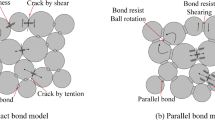Abstract
The influence of heterogeneity on mechanical and acoustic emission characteristics of rock specimen under uniaxial compress was studied with numerical simulation methods. Weibull distribution function was adopted to describe the mesoscopic heterogeneity of rocks. The failure process of heterogeneous rock specimen under uniaxial loading was simulated using FLAC3D software. Five schemes were adopted to investigate the influence of heterogeneity. The results demonstrate that as the homogeneity increases, the peak strength and brittleness of rocks increase, and the macro elastic modulus improves as well. Heterogeneity has great influence on macro elastic modulus and strength when the homogeneity coefficient is less than 20.0. The volume expansion is not so obvious when the homogeneity increases. As the homogeneity coefficient increases the acoustic emissions modes change from swarm shock to main shock. When the homogeneity coefficient is high, the cumulative acoustic emission events-axial strain curve is gentle before the rock failure. The numerical results agree with the previously numerical results and earlier experimental measurements.
Similar content being viewed by others
References
YOU Ming-qing, ZOU You-feng. Discussion on heterogeneity of rock material and size effect on specimen strength [J]. Chinese Journal of Rock Mechanics and Engineering, 2000, 19(3): 391–395. (in Chinese)
TANG C A, LIU H, LEE P, TSUI Y, THAM L G. Numerical tests on micro-macro relationship of rock failure under uniaxial compression. Part I: Effect of heterogeneity [J]. International Journal of Rock Mechanics and Mining Sciences, 2000, 37(4): 555–569.
LIU H Y, KOU S Q, LINDQVIST P A, TANG C A. Numerical modelling of the heterogeneous rock fracture process using various test techniques [J]. Rock Mechanics and Rock Engineering, 2007, 40(2): 107–144.
LI Ming-tian, FENG Xia-ting, ZHOU Hui. 2D vector cellular automata model for simulating fracture of rock under tensile condition [J]. Key Engineering Materials, 2004, 261/262/263: 705–710.
LI Ming-tian, FENG Xia-ting, ZHOU Hui. Cellular automata simulation of interaction mechanism of two cracks in rock under uniaxial compression [J]. International Journal of Rock Mechanics and Mining Sciences, 2004, 41(s1): 484–489.
ZHOU Hui, LI Ming-tian, FENG Xia-ting, WANG Shi-min, WANG Yong-jia. A new meso-mechanical approach for modeling the rock fracturing process [J]. International Journal of Rock Mechanics and Mining Sciences, 2004, 41(s1): 329–335.
MA Zhi-tao, TAN Yun-liang, ZHANG Ting. Modeling of rock failure based on physical cellular automata [J]. Journal of Southeast University, 2005, 21(3): 348–352. (in Chinese)
FENG Zeng-chao, ZHAO Yang-sheng, DUAN Kang-lian. Influence of rock cell characteristics and rock inhomogeneity parameter on complete curve of stress-strain [J]. Chinese Journal of Rock Mechanics and Engineering, 2004, 23(14): 2331–2335. (in Chinese)
ZHU W C, LIU J, TANG C A, ZHAO X D, BRADY B H. Simulation of progressive fracturing processes around underground excavations under biaxial compression [J]. Tunnelling and Underground Space Technology, 2005, 20(3): 231–247.
ZHU Wan-cheng, TANG Chun-an. Micromechanical model for simulating the fracture process of rock [J]. Rock Mechanics and Rock Engineering, 2004, 37(1): 25–56.
WANG Xue-bin. Volume change of heterogeneous quasi-brittle materials in uniaxial compression [J]. Journal of Wuhan University of Technology: Materials Science Edition, 2006, 21(3): 162–167.
WANG Xue-bin. Entire deformational characteristics and strain localization of jointed rock specimen in plane strain compression [J]. Journal of Central South University of Technology, 2006, 13(3): 300–306.
FU Yu-fang. Numerical simulation of brittle rock failure process [D]. Shenyang: Northeastern University, 2000: 67–71. (in Chinese)
LIANG Zheng-zhao. Three-dimensional failure process analysis of rock and associated numerical tests [D]. Shenyang: Northeastern University, 2005: 83–88. (in Chinese)
LIU H Y, ROQUETE M, KOU S Q, LINDQVIST P A. Characterization of rock heterogeneity and numerical verification [J]. Engineering Geology, 2004, 72(1/2): 89–119.
LIU H Y, KOU S Q, LINDQVIST P A, TANG C A. Numerical studies on the failure process and associated microseismicity in rock under triaxial compression [J]. Tectonophysics, 2004, 384(1/2/3/4): 149–174.
FENG Xia-ting, PAN Peng-zhi, ZHOU Hui. Simulation of the rock microfracturing process under uniaxial compression using an elasto-plastic cellular automaton [J]. International Journal of Rock Mechanics and Mining Sciences, 2006, 43(7): 1091–1108.
PAN P Z, FENG X T, HUDSON J A. Study of failure and scale effects in rocks under uniaxial compression using 3D cellular automata [J]. International Journal of Rock Mechanics and Mining Sciences, 2009, 46(4): 674–685.
MOGI K. Earthquake prediction [M]. Tokyo: Academic Press, 1985: 20–123.
TANG Chun-an. Numerical simulation of AE in rock failure [J]. Chinese Journal of Rock Mechanics and Engineering, 1997, 16(4): 368–374. (in Chinese)
LIANG Zheng-zhao, TANG Chun-an, HUANG Ming-li, FU Yu-fang. Numerical simulation of patterns of acoustic emission in rock failure process [J]. Journal of Northeastern University, 2002, 23: 1008–1011. (in Chinese)
Itasca Consulting Group. FLAC3D user’s manual (Version 3.0) [M]. Minneapolis, Minnesota: Itasca Consulting Group Inc, 2005.
CAI M, KAISE P K, TASAKA Y, MINAMI M. Determination of residual strength parameters of jointed rock masses using the GSI system [J]. International Journal of Rock Mechanics and Mining Sciences, 2007, 44(2): 247–265.
CAI M, KAISER P K, MORIOKA H, MINAMI M, MAEJIMA T, TASAKA Y, KUROSE, H. FLAC/PFC coupled numerical simulation of AE in large-scale underground excavations [J]. International Journal of Rock Mechanics and Mining Sciences, 2007, 44(4): 550–564.
Author information
Authors and Affiliations
Corresponding author
Additional information
Foundation item: Project(2007CB209407) supported by the National Basic Research Program of China; Project(50729904) supported by the National Natural Science Foundation of China
Rights and permissions
About this article
Cite this article
Li, Sc., Li, Gy. Effect of heterogeneity on mechanical and acoustic emission characteristics of rock specimen. J. Cent. South Univ. Technol. 17, 1119–1124 (2010). https://doi.org/10.1007/s11771-010-0605-2
Received:
Accepted:
Published:
Issue Date:
DOI: https://doi.org/10.1007/s11771-010-0605-2



